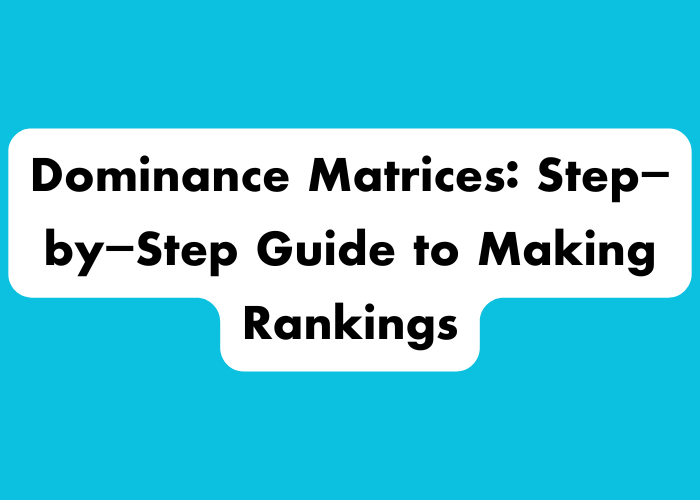Dominance Matrices: Step-by-Step Guide to Making Rankings
Dominance matrices are used to represent and analyze the outcomes of round-robin competitions, where each competitor faces every other competitor. This guide will show you how to create dominance matrices and use them to rank competitors effectively.
What are Dominance Matrices?
A dominance matrix is a numerical representation of which competitor dominates others within a competition. The matrix uses values of 1 and 0 to indicate dominance relationships between competitors.
Creating a Dominance Matrix
- Label Columns and Rows: Label each row and column with the competitors’ names in the same order.
- Enter Results: For each row, place a 1 under the columns of competitors they beat and a 0 for those they did not beat.
Example: For competitors A, B, C, D, E with the following results:
- A beat D and E
- B beat A
- C beat A, B, and D
- D beat B and E
- E beat B and C
The dominance matrix will look like:
| A | B | C | D | E | |
|---|---|---|---|---|---|
| A | 0 | 0 | 0 | 1 | 1 |
| B | 1 | 0 | 0 | 0 | 0 |
| C | 1 | 1 | 0 | 1 | 0 |
| D | 0 | 1 | 0 | 0 | 1 |
| E | 0 | 1 | 1 | 0 | 0 |
Understanding Two-Stage Paths in a Digraph
In any directed graph (digraph), when we raise the matrix MMM to the power of 2 (i.e., M2M^2M2), the resulting matrix represents the two-stage paths between nodes in the graph. This method of matrix powers allows us to determine how nodes are connected through intermediary stages.
Key Concepts:
- Two-Stage Paths: The matrix M2M^2M2 shows all paths between nodes that can be completed in exactly two steps. For example, if AAA connects to BBB in two steps through CCC, this path would be reflected in M2M^2M2.
- Higher Stage Paths: Extending this idea, raising the matrix MMM to higher powers, such as M3M^3M3, reveals three-stage paths, and so on. For any MnM^nMn, the matrix shows nnn-stage paths between nodes.
Example: Two-Stage and Three-Stage Paths in a Digraph
Let’s consider the digraph with the following matrices for M2 and M3:
Matrix M2 (Two-Stage Paths)
M2 = [ 0 0 0 0 ]
[ 0 0 1 0 ]
[ 0 0 0 0 ]
[ 0 0 1 0 ]
This matrix shows the number of two-stage paths between the nodes in the digraph:
- The second row indicates a two-stage path from node 2 to node 3.
- The fourth row indicates a two-stage path from node 4 to node 3.
- No other two-stage paths exist, as shown by the zeros elsewhere in the matrix.
Matrix M3 (Three-Stage Paths)
M3 = [ 0 0 0 0 ]
[ 0 0 0 0 ]
[ 0 0 0 0 ]
[ 0 0 0 0 ]
The matrix M3 is a zero matrix, meaning that no three-stage paths exist between any nodes in the digraph.
Interpretation
- Two-Stag
In this case, the M2M^2M2 matrix shows that there are exactly two two-stage paths, both originating from node CCC. On the other hand, M3M^3M3 is a zero matrix, meaning no three-stage paths exist in the network.
Ranking Using Dominance Matrices
- Sum Rows: Add the numbers in each row to get a score for each competitor.
- Rank Competitors: Higher scores indicate higher rankings.
Example Rankings:
- A: 2 (2nd place)
- B: 1 (5th place)
- C: 3 (1st place)
- D: 2 (2nd place)
- E: 2 (2nd place)
Application in Competitions:
If this digraph represents the results of a tennis tournament, where nodes are players, and edges represent wins, the entries in matrix MMM (with 1s and 0s) show the results of direct matches. The two-stage paths in M2M^2M2 illustrate indirect wins: for instance, if Player CCC beats Player AAA, and AAA beats BBB, then CCC is indirectly superior to BBB.
Ranking the Players:
By analyzing the matrix MMM, we can determine that Player CCC has the most wins based on the row sums. Furthermore, the two-stage paths provide additional insights into the relative strength of players. Even if CCC did not play BBB or DDD directly, the two-stage paths indicate that CCC is likely stronger, as CCC beat someone who won against both BBB and DDD.
If no three-stage paths exist, as indicated by the zero matrix M3M^3M3, there is no further evidence to differentiate the players beyond two stages. Players with the same column sum in M2M^2M2, like BBB and DDD, can be considered equally ranked based on available data.
Second Order Rankings
Second order rankings consider indirect dominance relationships. To find second order dominances:
- Square the Dominance Matrix: Compute D2D^2D2 to find indirect influences.
- Sum Rows of D2D^2D2: This gives second order dominance scores.
Supremacy Matrix
The supremacy matrix SSS combines direct and indirect dominances: S=D+12D2S = D + \frac{1}{2}D^2S=D+21D2
Example: Calculate the supremacy matrix and sum the rows to determine refined rankings, especially useful for breaking ties.
Limitations
- Sample Size: Results may be based on a small number of matches.
- Dynamic Changes: Teams may improve or worsen over time.
- External Factors: Does not account for factors like home advantage or player injuries.
Example 1
Consider the network diagram below.
Part a: Create the Dominance Matrix M for this network
To build the dominance matrix, observe the connections between the nodes. Represent each connection by a 1 in the corresponding position in the matrix.
Part b: Find the Second Stage Dominance Matrix M2
The second stage dominance matrix M2 is found by squaring the matrix M. Each entry in M2 shows the number of two-step paths between nodes.
Part c: Calculate T = M + M2
To rank the players, we calculate T by adding the matrix M and M2 together. This gives a matrix that reflects both direct and two-step connections between the nodes.
Part d: Determine the Dominant Node
The dominant node is determined by finding the row in matrix T with the highest sum. This node has the most direct and indirect connections to others.
Conclusion
Dominance matrices are powerful tools for ranking competitors in round-robin tournaments. By understanding and applying these methods, you can make informed predictions and analyses in various competitive scenarios.


